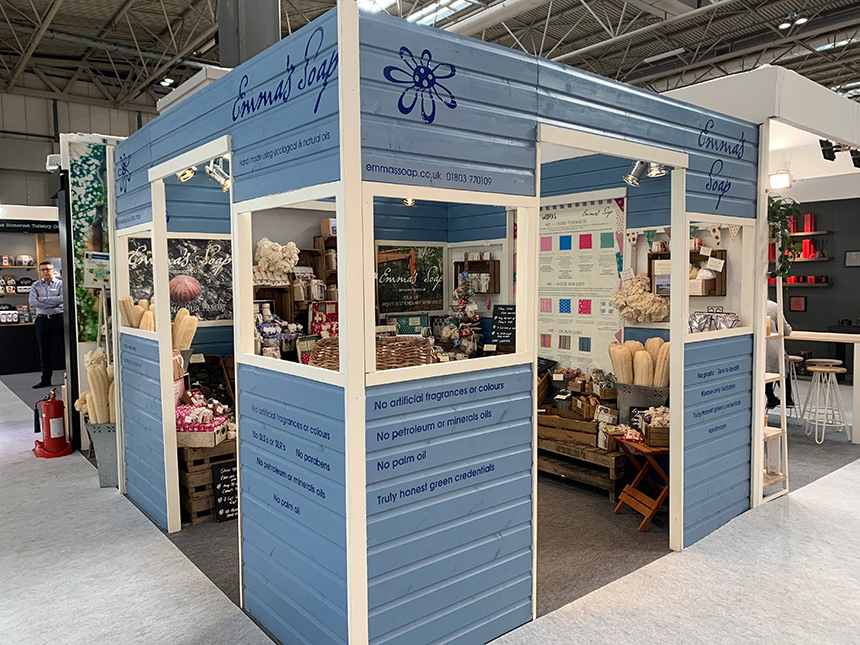Emma’s Soap has caught the attention of retailers and customers throughout the UK, becoming known for its ethical, sustainable and environmentally friendly processes, from start to finish.
Homemade in Devon, Emma’s Soap uses a blend of natural oils to create her unique recipe. Emma looked to create a product which she would be happy to use, wanting to avoid the use of harsh chemicals on the skin. She has since gone on to create a recognisable brand, focusing on educating her customers on the importance of reusing, reducing and recycling.
Emma spoke exclusively with Modern Retail about her ongoing journey to creating the most effective and ethical soap on the market.
MR: How did Emma’s Soap begin?
Emma: It was born out of necessity because I couldn’t find anything I was happy to put on my own skin. There was nothing which was environmentally sustainable and also naturally cleaned and moisturised the skin. I started giving it to my friends and family and we went from there, making more, and I’m still doing the same almost nine years later
MR: How did you decide which ingredients to use?
Emma: The ingredients are key. It took me eight months to perfect for recipe for the soap. I only use the best quality oils, so it’s extra virgin olive oil and oils which are unrefined so they have no bleach in them. I don’t add any preservatives because you don’t need them. There are no foaming agents because I use coconut oil, which gives it the beautiful lather. There are no parabens, artificial fragrances, colours, SLS’s or SLR’s. Your skin is the largest organ in the body and it’s semi-permeable, so you need to know what you’re putting on it.
I wanted to make products you could use to wash your face, body, hair and clothes, with bars including shampoo bars and a shaving soap.
MR: How did you decide on what to package your products in?
Emma: Once you have your product sorted, you need to consider your options for packaging carefully. Recycling paper is not perpetual and you have to mix it with FSC to give it strength. I was very concerned about compostable and sisal as they’re chopping down rainforests to grow the sisal and make the compostable packaging… so I came up with organic fairtrade cotton as the right option for my soaps.
I decided on organic because of the pesticides for the cotton pickers’ health and safety, and fair trade because it means there is a fair price and everybody is happy. With organic fairtrade cotton, I am able to package soaps beautifully, ready to go, even as a gift because of how great they look.
We have five different base oils to suit customers’ varying skin types, and each links with the scent. Ironically, this packaging has also become part of the labelling, with a multifunctional role, triggering people’s memories of which scent they love most.
MR: What are the difficulties you faced when sourcing packaging?
Emma: Every type of packaging has its pros and cons. There is an argument with the amount of water used for cotton production and I understand that. With packaging, you really have to look at the pitfalls of all the different packaging. The best thing you can perpetually recycle is tin, but then the cost would go up substantially. Whatever you do, you will be criticised and you have to compromise and work out the best, realistic options. Sometimes you have to sit back and look at the damage your packaging is causing, weighing it up against the benefits it’s bringing.
MR: How do you look to educate your customers?
Emma: I create a lot of materials for customers which help them to do their bit. I even extend to gift boxes as well as the packaging. On the label, it says ‘Top your jams and chutneys or make your best-loved dolly a dress. Whatever you do, don’t throw me away.’ I encourage customers to use the boxes as a button box or a dolly’s bed and give out bunting patterns. It’s all about getting people to think about their decisions. I also give customers the option to return all their packaging to get 5p off their next purchase. Every week, I get envelopes full of boxes, read booklets, labels and fabric. We’ve had people make earring bags, Christmas tree decorations and even patching their jeans. It’s beautiful… you’re sparking the conscience of the consumer and reminding them that all of this doesn’t have to go into landfill and it can be reused.
I even make cards with photography of native wildlife in Scotland because I found that the card industry wasn’t using recycled card or compostable bags. I tried to make this completely eco, taking pictures of native animals and creating the postcards using recycled card and vegetable ink, with cornstarch wrappers. Then when it’s sent out to someone, I include a sticker in the envelope so it can be reused and get a second life. Everything I do is about being environmentally friendly through the entire cycle.

